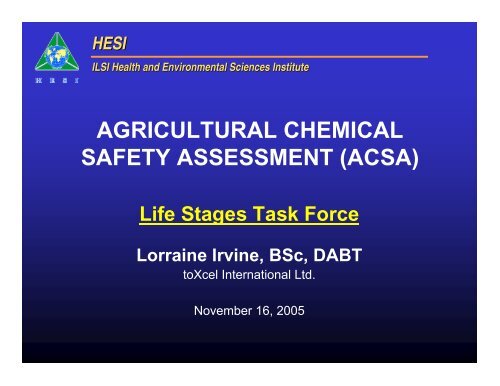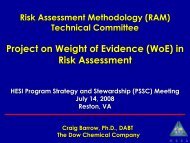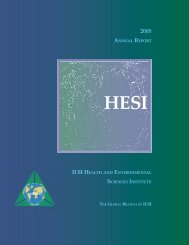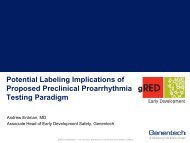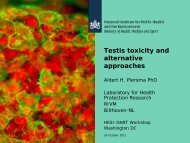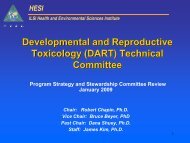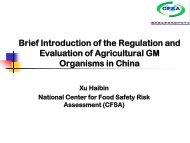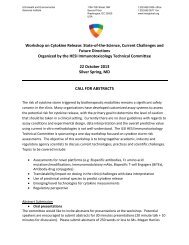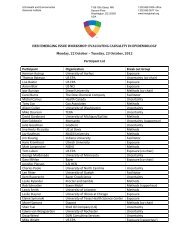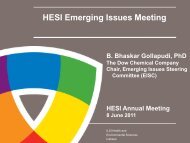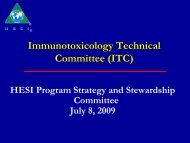Life Stages Task Force - ILSI Health and Environmental Sciences ...
Life Stages Task Force - ILSI Health and Environmental Sciences ...
Life Stages Task Force - ILSI Health and Environmental Sciences ...
You also want an ePaper? Increase the reach of your titles
YUMPU automatically turns print PDFs into web optimized ePapers that Google loves.
HESI<br />
<strong>ILSI</strong> <strong>Health</strong> <strong>and</strong> <strong>Environmental</strong> <strong>Sciences</strong> Institute<br />
AGRICULTURAL CHEMICAL<br />
SAFETY ASSESSMENT (ACSA)<br />
<strong>Life</strong> <strong>Stages</strong> <strong>Task</strong> <strong>Force</strong><br />
Lorraine Irvine, BSc, DABT<br />
toXcel International Ltd.<br />
November 16, 2005
HESI<br />
<strong>ILSI</strong> <strong>Health</strong> <strong>and</strong> <strong>Environmental</strong> <strong>Sciences</strong> Institute<br />
<strong>Life</strong> <strong>Stages</strong> <strong>Task</strong> <strong>Force</strong><br />
Dr. Ralph Cooper (Co-Chair)<br />
US EPA NHEERL<br />
Dr. Sue Barlow<br />
Consultant<br />
Dr. Karin Bentley<br />
DuPont Crop Protection<br />
Dr. Ann Blacker<br />
Bayer CropScience<br />
Dr. Angela Brady<br />
Syngenta CTL<br />
Ms. Janet Diliberto<br />
US EPA NHEERL<br />
Dr. David Eisenbr<strong>and</strong>t<br />
Dow Agro<strong>Sciences</strong><br />
Dr. Penny Fenner-Crisp<br />
<strong>ILSI</strong> Risk Science Institute<br />
Dr. Ron Hines<br />
Medical College of Wisconsin<br />
Dr. Jim Lamb (Co-Chair)<br />
THE WEINBERG GROUP, Inc.<br />
Ms. Lorraine Irvine<br />
toXcel International<br />
Dr. Carole Kimmel<br />
US EPA NCEA<br />
Dr. Herman Koeter<br />
European Food Safety Authority<br />
Dr. Abby Li<br />
Exponent<br />
Dr. Larry Sheets<br />
Bayer Corporation<br />
Dr. Gerrit J.A. Speijers<br />
RIVM, Natl. Inst. Public <strong>Health</strong> & Envt.<br />
Dr. Karen Whitby<br />
US EPA Office of Pesticide Programs
HESI<br />
<strong>ILSI</strong> <strong>Health</strong> <strong>and</strong> <strong>Environmental</strong> <strong>Sciences</strong> Institute<br />
<strong>Life</strong> <strong>Stages</strong> <strong>Task</strong> <strong>Force</strong> Objectives<br />
• Reduce / refine/ replace animal usage<br />
• Optimize study design / allow flexibility<br />
• Exposure characteristics taken into account<br />
(route, level, frequency, duration)<br />
• Facilitate risk assessments for relevant lifestages<br />
• Tiered approach to testing<br />
Conolly, R.B. et al., Stimulating research to improve the scientific ific basis of risk assessment.<br />
Toxicol Sci. 49: 1-4, 1<br />
1999.<br />
Goodman, J.I. The traditional toxicologic paradigm is correct: dose d<br />
influences mechanism.<br />
Environ <strong>Health</strong> Perspect. 106, Suppl. 1: 285-288, 288, 1998.
HESI<br />
<strong>ILSI</strong> <strong>Health</strong> <strong>and</strong> <strong>Environmental</strong> <strong>Sciences</strong> Institute<br />
Required<br />
Food-use Pesticide: Current Testing<br />
• Prenatal developmental: 2 species<br />
• 2-generation reproduction: 1 species<br />
Conditional / Case-by-case<br />
• Developmental neurotoxicity<br />
• Endocrine modulation assessment<br />
• Developmental immunotoxicity<br />
• (for EU) TK at selected life stages
HESI<br />
<strong>ILSI</strong> <strong>Health</strong> <strong>and</strong> <strong>Environmental</strong> <strong>Sciences</strong> Institute<br />
• ‘Inevitable’ progression to conditional /<br />
case-by-case studies<br />
• High dose complications<br />
• Relevance of route of administration<br />
• Duplication of exposures<br />
• Increasing use of animals<br />
Problems with Current Testing<br />
• Concern not addressing key life stages
HESI<br />
<strong>ILSI</strong> <strong>Health</strong> <strong>and</strong> <strong>Environmental</strong> <strong>Sciences</strong> Institute<br />
• Reviewed existing tiered testing<br />
approaches<br />
<strong>Life</strong> <strong>Stages</strong> Review <strong>Task</strong>s<br />
• Examined existing screens (including<br />
in vitro) <strong>and</strong> their value in risk assessment<br />
• Considered ADME <strong>and</strong> TK needs <strong>and</strong> their<br />
integration into life stages evaluation<br />
• Risk assessments for different life stages
HESI<br />
<strong>ILSI</strong> <strong>Health</strong> <strong>and</strong> <strong>Environmental</strong> <strong>Sciences</strong> Institute<br />
Examples of Tiered Approach<br />
Chemicals<br />
• OECD SIDS <strong>and</strong> US EPA HPV<br />
• NONS (92/32/EEC) or TSCA PMN<br />
Pharmaceuticals<br />
• ICH (human)<br />
• VICH (veterinary drug residues)<br />
Principle of tiered testing accepted by public/<br />
regulators
HESI<br />
<strong>ILSI</strong> <strong>Health</strong> <strong>and</strong> <strong>Environmental</strong> <strong>Sciences</strong> Institute<br />
Considerations of <strong>Life</strong> <strong>Stages</strong> Tiered Approach<br />
Risk assessments drive the studies<br />
Objectives of Tier 1<br />
• Determine effects on reproduction<br />
• Determine sensitivity of life stages<br />
(other than young adult) to major<br />
toxicities
HESI<br />
<strong>ILSI</strong> <strong>Health</strong> <strong>and</strong> <strong>Environmental</strong> <strong>Sciences</strong> Institute<br />
Base set (Tier 1)<br />
Considerations of <strong>Life</strong> <strong>Stages</strong> Tiered Approach<br />
• Conduct exposure estimates (route, duration,<br />
amount)<br />
• Consider life stages to be protected<br />
• Use relevant group sizes for biological /<br />
statistical confidence in results<br />
• Include key indicators (triggers) which, if<br />
negative, give a high level of confidence of no<br />
adverse effects If positive Tier 2<br />
• Conduct risk assessment If low MOE Tier 2
HESI<br />
<strong>ILSI</strong> <strong>Health</strong> <strong>and</strong> <strong>Environmental</strong> <strong>Sciences</strong> Institute<br />
Considerations of <strong>Life</strong> <strong>Stages</strong> Tiered Approach<br />
Tier 2<br />
• Exposure studies or refined estimates<br />
• Focused second tier studies to quantify /<br />
characterize specific effect at biologically<br />
relevant doses<br />
• Conduct risk assessment
HESI<br />
<strong>ILSI</strong> <strong>Health</strong> <strong>and</strong> <strong>Environmental</strong> <strong>Sciences</strong> Institute<br />
Considerations of <strong>Life</strong> <strong>Stages</strong> Tiered Approach<br />
Risk assessments involving life stages<br />
• Dietary: acute <strong>and</strong> chronic<br />
– Infants, 1-6, 7-12, 13-19, >55 years<br />
• Residential: short-term, intermediate, longterm<br />
– Toddlers, adults (females 13+ years)<br />
• Occupational: short-term, intermediate,<br />
long-term<br />
– Females 13+ years, males 13+ years
HESI<br />
<strong>ILSI</strong> <strong>Health</strong> <strong>and</strong> <strong>Environmental</strong> <strong>Sciences</strong> Institute<br />
Base Set (Tier 1) <strong>Life</strong> <strong>Stages</strong> Studies<br />
• F1-’extended’ one-generation<br />
reproduction study in one species<br />
(most probable = rat)<br />
• Developmental toxicity study in second<br />
species<br />
(most probable = rabbit)
HESI<br />
<strong>ILSI</strong> <strong>Health</strong> <strong>and</strong> <strong>Environmental</strong> <strong>Sciences</strong> Institute<br />
Considerations for Base Set (Tier 1) Testing<br />
• Consider systemic toxicity, ADME, <strong>and</strong><br />
other relevant data → refine toxicity<br />
endpoints for inclusion<br />
• Administration by route of relevant human<br />
exposure (dietary preferred over gavage:<br />
adjust dosage to dietary intake)<br />
• ADME to determine “internal dose” <strong>and</strong><br />
kinetics<br />
• Relate “internal dose” in risk assessment
HESI<br />
<strong>ILSI</strong> <strong>Health</strong> <strong>and</strong> <strong>Environmental</strong> <strong>Sciences</strong> Institute<br />
F1-’extended<br />
extended’: : 1-Gen 1<br />
Study<br />
P♂<br />
Pre X: 4W<br />
X: 2W<br />
Post X: up to 6W<br />
P♂ & P♀<br />
necropsy<br />
P♀<br />
Pre X: 2W<br />
Gestation<br />
Lactation<br />
Post wean: up to PND 70<br />
Set 1 : clinical path/ neurotox<br />
Post wean: up to PND 70<br />
Set 2 : estrous cycles / immunotox<br />
Post wean: up to PND 70<br />
Set 3 : TK / triggered reprotox - extend to F2<br />
Surplus F1 pup<br />
necropsy<br />
P♂ & ♀ dosing<br />
Selected subsets F1♂ & ♀ dosing
HESI<br />
<strong>ILSI</strong> <strong>Health</strong> <strong>and</strong> <strong>Environmental</strong> <strong>Sciences</strong> Institute<br />
P generation<br />
F1-’extended<br />
extended’: : 1-Gen 1<br />
Study<br />
• N = sufficient for 20 litters / group<br />
• Use ADME / TK in dose setting<br />
• TK estimates at key stages of gestation / lactation<br />
• Comprehensive repro evaluations<br />
• Detailed histopathology on subset<br />
• Use ‘markers’ for other toxicities identified from<br />
systemic toxicity studies<br />
• Consider preliminary in vitro tests for potential<br />
mechanisms <strong>and</strong> refinement of endpoints
HESI<br />
<strong>ILSI</strong> <strong>Health</strong> <strong>and</strong> <strong>Environmental</strong> <strong>Sciences</strong> Institute<br />
F1-’extended<br />
extended’: : 1-Gen 1<br />
Study<br />
F1 generation (continues dosing to PND 70)<br />
• Pre-wean (AG, sex, body weight, clinical observations)<br />
• At PND 21, select 3 subsets (each 1♂ <strong>and</strong> 1♀)<br />
• Surplus PND 21 pups (organ weight, histopathology,<br />
including neurological tissue)<br />
• Set 1: Motor activity, FOB, neuropathology, clinical<br />
chemistry, hematology, thyroid hormones, detailed<br />
histopathology<br />
• Set 2: estrous cycles, immunotox (SRBC antibody<br />
response; triggered phenotypic analysis of lymphocytes<br />
(if +) or natural killer cell assay (if -))<br />
• Set 3: TK, endocrine, repro, <strong>and</strong>, if triggered, continue<br />
dosing beyond PND 70 <strong>and</strong> mate for F2 generation
HESI<br />
<strong>ILSI</strong> <strong>Health</strong> <strong>and</strong> <strong>Environmental</strong> <strong>Sciences</strong> Institute<br />
Developmental Toxicity Study<br />
Single developmental toxicity study in different<br />
species (likely rabbit)<br />
• Design based on OPPTS 870.3700 / OECD 414<br />
• Relevant human exposure route, but with dietary<br />
preferred over gavage<br />
• Use ADME / TK in dose setting <strong>and</strong> measure TK<br />
• Use ‘markers’ for toxicities identified from other<br />
studies, including histopathology<br />
• Consider preliminary in vitro tests for potential<br />
mechanisms <strong>and</strong> refinement of endpoints
HESI<br />
<strong>ILSI</strong> <strong>Health</strong> <strong>and</strong> <strong>Environmental</strong> <strong>Sciences</strong> Institute<br />
Potential Reduction in Animal Usage<br />
Current testing guidelines<br />
• 2 species developmental tox (parental) 160<br />
• 2-gen reprotox (parental <strong>and</strong> offspring) 2600<br />
• Developmental neurotox (parental <strong>and</strong> offspring) 1280<br />
• Developmental immunotox (parental <strong>and</strong> offspring) 1280<br />
5320<br />
Tier 1 testing only<br />
• 1 species developmental tox (parental) 80<br />
• Extended 1-gen reprotox (parental & offspring) 1400<br />
1480<br />
(If 2 nd generation triggered) (+1200)
HESI<br />
<strong>ILSI</strong> <strong>Health</strong> <strong>and</strong> <strong>Environmental</strong> <strong>Sciences</strong> Institute<br />
Considerations for Tier 2 Testing<br />
Low MOE or triggers from Tier 1 testing lead to<br />
focused Tier 2 testing<br />
• Case-by-case special studies to characterise<br />
effect(s)<br />
• Conducted at relevant (not MTD) doses<br />
• May include: further neurotox, immunotox, or<br />
endocrine tests, late-in-life sensitivity, fetal /<br />
neonatal ADME, detailed mode-of-action endpoints<br />
• May include : 2-gen repro <strong>and</strong>/or second species<br />
developmental tox
HESI<br />
<strong>ILSI</strong> <strong>Health</strong> <strong>and</strong> <strong>Environmental</strong> <strong>Sciences</strong> Institute<br />
Gains from Modified Approach<br />
• Use of toxicokinetic <strong>and</strong> young adult systemic<br />
toxicity data in designing studies<br />
• Assessment of systemic toxicity in young<br />
adults as a consequence of pre- <strong>and</strong> early<br />
postnatal exposure<br />
• Developmental neurotoxicity assessment<br />
• Developmental immunotoxicity assessments<br />
• Assessment of multiple types of outcomes<br />
from the same population of animals<br />
• Fewer numbers of animals used
HESI<br />
<strong>ILSI</strong> <strong>Health</strong> <strong>and</strong> <strong>Environmental</strong> <strong>Sciences</strong> Institute<br />
Concessions under New Approach<br />
• Shorter pre-mating exposures for males (4<br />
weeks) <strong>and</strong> females (2 weeks) than the<br />
current 10-week period (although considered<br />
adequate for fertility assessment).<br />
• Only mating F1 animals <strong>and</strong> producing an F2<br />
generation if triggered.<br />
• No prenatal developmental toxicity study in<br />
the rat.


